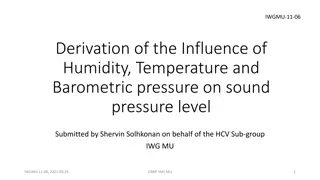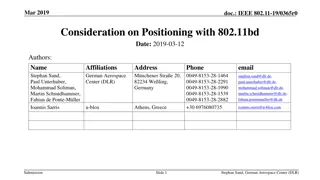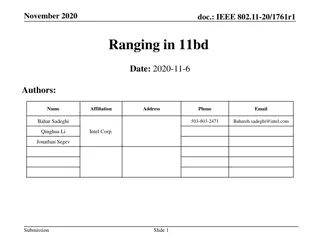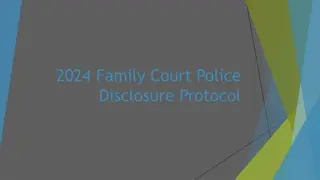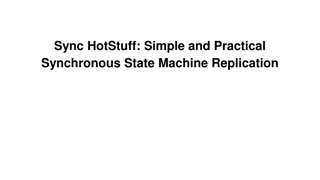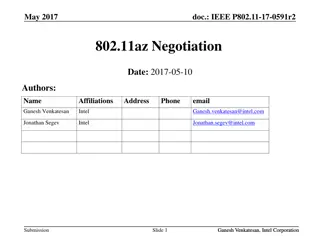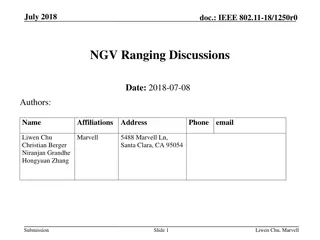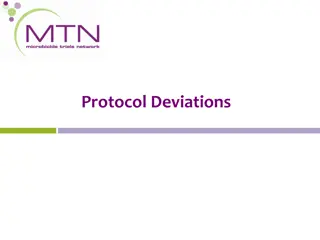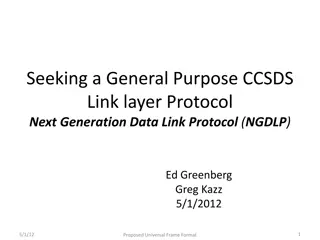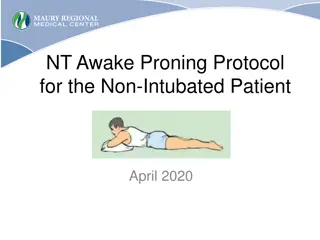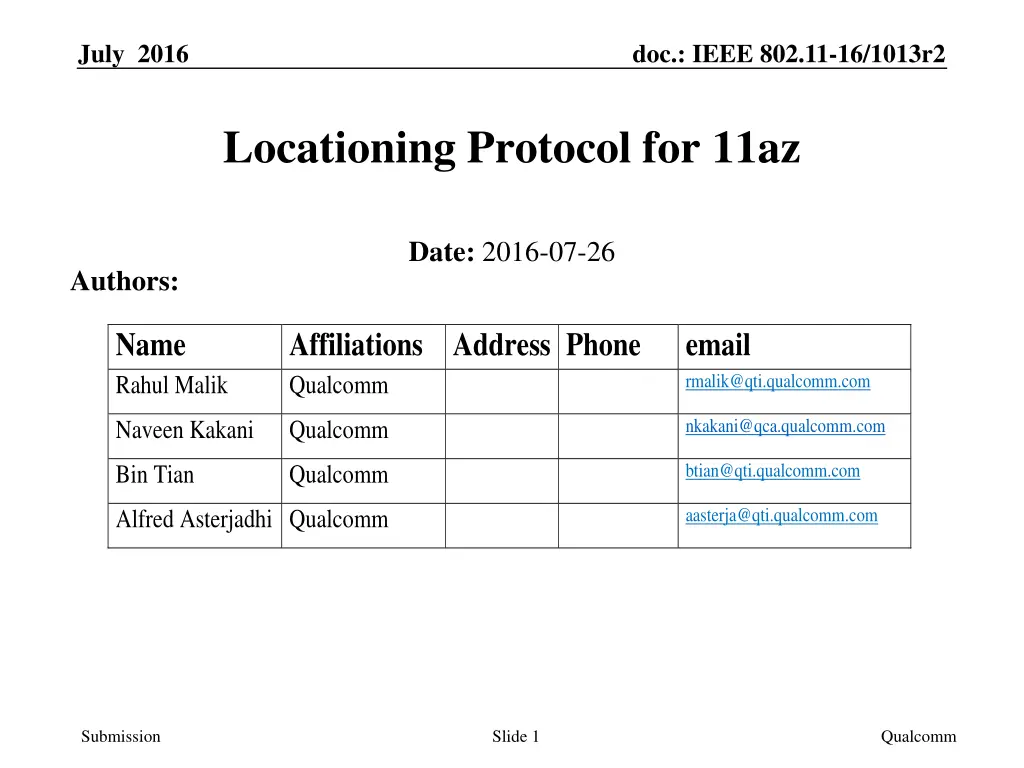
IEEE 802.11az Locationing Protocol Overview
Delve into the July 2016 IEEE 802.11-16/1013r2 document focusing on the background, objectives, and channel estimation sequence for the 11az protocol. Explore proposals for low-overhead MIMO channel estimation and leveraging the HE packet extension field for improved accuracy in positioning techniques.
Download Presentation

Please find below an Image/Link to download the presentation.
The content on the website is provided AS IS for your information and personal use only. It may not be sold, licensed, or shared on other websites without obtaining consent from the author. If you encounter any issues during the download, it is possible that the publisher has removed the file from their server.
You are allowed to download the files provided on this website for personal or commercial use, subject to the condition that they are used lawfully. All files are the property of their respective owners.
The content on the website is provided AS IS for your information and personal use only. It may not be sold, licensed, or shared on other websites without obtaining consent from the author.
E N D
Presentation Transcript
July 2016 doc.: IEEE 802.11-16/1013r2 Locationing Protocol for 11az Date: 2016-07-26 Authors: Name Rahul Malik Affiliations Address Phone Qualcomm email rmalik@qti.qualcomm.com nkakani@qca.qualcomm.com Naveen Kakani Qualcomm btian@qti.qualcomm.com Bin Tian Qualcomm aasterja@qti.qualcomm.com Alfred Asterjadhi Qualcomm Submission Slide 1 Qualcomm
July 2016 doc.: IEEE 802.11-16/1013r2 Background 11az 11az tasked to specify MAC/PHY techniques to enable better positioning Requirements: improved accuracy lower overhead/improved scalability Approaches to get there angular techniques Refined FTM passive positioning 60GHz etc Improving positioning accuracy is inherently a channel estimation problem Resolution of MIMO channels can lead to better location accuracy range and angle 11az timelines indicate a launch after 11ax and companies will invest in new silicon for 11ax Can we leverage 11ax packet structures/sequences to enable improved accuracy positioning with lower overhead? Submission Slide 2
July 2016 doc.: IEEE 802.11-16/1013r2 Proposal Objectives Define a sequence that Achieves low-overhead MIMO channel estimation for locationing Can be embedded in any packet limiting overhead of a dedicated packet exchange sequence when continuous positioning is required Define a protocol that Supports Network-based and STA-side positioning Associated and unassociated STA positioning Triggered and Contention-based TXOPs Improves medium utilization efficiency i.e. limits overhead (eg: can piggyback data) Allows Implementation Flexibility processing time etc Submission Slide 3 Qualcomm
July 2016 doc.: IEEE 802.11-16/1013r2 Channel Estimation Sequence Submission Slide 4
July 2016 Embed a Channel Estimation Sequence in the HE Packet Extension Field doc.: IEEE 802.11-16/1013r2 Leverage the HE Packet Extension Field to define a low overhead channel estimation sequence 11ax does not currently specify the contents of the PE 11ax allows for a variable length PE 0/4/8/12/16us Tx determines minimum PE length to be used based on Rx capability and rules defined in 11ax Tx may additionally add/extend the PE -> as per current 11ax specification Proposal 11az specifies at least one mode of operation with transmission of channel-estimation sequences (eg: LTFs) during the PE field Use of this mode may be signaled - eg: via HE-SIG field Standard specifies an appropriate LTF-mapping (P-matrix) and spatial-mapping Q-matrix See next slide Standard specifies the sequences that are used for different tx-antenna configurations and PE durations See next slide Slide 5 Submission Qualcomm
July 2016 doc.: IEEE 802.11-16/1013r2 Sounding PE Definition Use a P-matrix (for example as shown below) that allows for orthogonalization of LTFs from different antennas Depending on PE duration chosen by Tx, some # of Tx antennas can be supported as shown below PE is not beam-formed Rx may leverage initial AGC gain setting (from Legacy Preamble section to receive the PE) Max resolution loss of 1.5bits assuming max beamforming gain with 8 Tx antennas [practical cases would be lower] Sufficient resolution for channel estimation Q-matrix is specified in the standard to be 11az friendly eg: an I-matrix PE duration (us)/Tx-antenna LTF-1 LTF-2 LTF-3 LTF-4 0 NA NA NA NA 4/1 +1 8/1 1 -1 8/2 1 1 12/1 1 -1 Repeat LTF-1 12/2 1 1 Repeat LTF-1 16/1 1 -1 1 1 16/2 1 1 -1 1 16/3 1 1 1 -1 16/4 -1 1 1 1 16/5~16/8 Repeat 16/1~16/4 with specified CSD Submission Slide 6
July 2016 doc.: IEEE 802.11-16/1013r2 CIR of 2-antennas using CSD Eg CIR in Chan D, K = 3dB with CSD of 400ns 90 80 X: 94 Y: 83.73 X: 125 Y: 70.31 70 60 50 40 30 20 10 0 0 50 100 150 200 250 300 Example CIR of two antennas multiplexed using CSD Submission Slide 7 Qualcomm
July 2016 doc.: IEEE 802.11-16/1013r2 Locationing Protocol Submission Slide 8
July 2016 doc.: IEEE 802.11-16/1013r2 Objectives Leverage 11ax sequences Triggered/Scheduled operation Contention based TXOP operation Single TXOP Implementation flexibility Define a framework that allows for locationing information to be available at either entity (initiator OR responder) Actual information to be shared can be negotiated based on privacy considerations, use-case, compute capabilities etc Submission Slide 9 Qualcomm
July 2016 doc.: IEEE 802.11-16/1013r2 Triggered Frame Exchange PE contains sounding sequence used for locationing Can be data-frames/de-limiters/ ActionNoACK (eg: LCI information) AP can: (1) refine AoA; (2) compute AoD wrt STA (3) refine t4 (4) OPTIONALLY COMPUTE RANGE Triggered Response AP can compute (1) coarse AoA (2) coarse t4 here Critical Path AP decides pad TRIGGER FRAME Device can optionally insert T1 T1/T4; optionally AoA/ AoD@AP; optionally range AP Preamble PE ACK Preamble Optional (T2/T3/AoA/ AoD) Optional (T2/T3/AoA/ AoD) Optional (T2/T3/AoA/ AoD) Preamble type of response frame can be specified by trigger STA1 Preamble PE Single TXOP MU operation MAY be used to sound multiple devices Use of sounding PE eliminates additional overhead of NDP exchange allow for piggybacking sounding on data Currently specified AMPDU contexts allow for piggybacking data/ack/management transmission Framework allows device to relax its response- time (critical-path) based on capability Framework allows flexibility to either entity to perform location computations Preamble PE STA... STAn Preamble PE STAs can: (1) refine t2; (2) refine AoA (3) compute AoD from PE STAs can compute: (1) coarse t2; (2) coarse AoA Submission Slide 10 Qualcomm
July 2016 doc.: IEEE 802.11-16/1013r2 Contention Based Frame Exchange AP can compute: (1) Refined AoA (2) Refined AoD (3) Refined t2 Contention Based TXOP AP can compute: (1) Coarse AoA; (2) Coarse t2 Critical Path Responder Determines pad T2, T3, AoA/ AoD@AP AP RESPONDER Preamble ACK PE STA Preamble PE INITIATOR STA can compute: (1) fine AoA (2) AoD (3) fine t4 STA can compute (1) coarse AoA (2) coarse t4 PE contains sounding sequence used for locationing Can be data-frames/de-limiters/ ActionNoACK (eg: LCI information) Simplest 802.11 construct of request/response limited frame overhead Submission Slide 11 Qualcomm
July 2016 doc.: IEEE 802.11-16/1013r2 Requirements Method to indicate presence of sounding sequence in PE Indicate via a reserved bit in HE-SIG-A Sounding Sequence has a unique pattern that can be used to detect presence of sounding PE and number of Tx antennas [Rx would correlate against expected sounding sequence to determine presence and hence # Tx antennas] Sounding PE indicated via MAC header Sounding PE indicated via a new trigger-type Presence of sounding PE pre-negotiated between AP and STA PE Duration and Antenna Configuration PE duration signaled via existing 11ax fields in HE-SIG-A Mapping between PE durations and allowed antenna configurations specified by 11az Note that some of the requirements identified above can be promoted by TGaz as recommended changes to 11ax for better positioning Submission Slide 12 Qualcomm
July 2016 doc.: IEEE 802.11-16/1013r2 Alignment with 802.11ax Leverage Existing 11ax Sequences MU/OFDMA: Trigger -> Data -> DL-ACK Contention Based SU: Data -> ACK Reuse existing fields in 11ax frames for 11az functionality Fully backwards compatible with 11ax devices that don t support 11az Defined sequence can piggy-back on data exchange do not need a dedicated exchange for sounding Efficient overlay of locationing on data communications Enables use-cases for more frequent location updates Submission Slide 13 Qualcomm
July 2016 doc.: IEEE 802.11-16/1013r2 Discussion? How do we signal presence of locationing sequence in packet extension? Performance improvements with > 4 antennas? Submission Slide 14 Qualcomm
Simulation Results Submission Slide 15
July 2016 doc.: IEEE 802.11-16/1013r2 Simulation Environment IEEE Channel D-LOS K=3dB (default specified for large office environment) K = 6, 10dB increased strength of LOS component for additional comparison Modifications Make K-factor configurable Make AoA of the first cluster configurable Randomize the AoA of the 2nd and 3rd clusters Tx (2-antenna) & Rx (4-antenna) are Uniform Linear Arrays with lambda/2 spacing Submission Slide 16 Qualcomm
July 2016 doc.: IEEE 802.11-16/1013r2 Changes to Angular Parameters on IEEE Channel D-LOS for AoA MAKE CONFIGURABLE MAKE RANDOM MAKE RANDOM Submission Slide 17 Qualcomm
July 2016 doc.: IEEE 802.11-16/1013r2 Evaluation Evaluate AoA performance using for 2 antenna Tx/4- antenna Rx using MUSIC for Case#1: 2xLTFs separated by CSD of 200ns Eg: antenna #1 and #5 using packet extension approach Case#2: 2xLTFs orthogonalized by P-matrix codes Submission Slide 18 Qualcomm
July 2016 doc.: IEEE 802.11-16/1013r2 AoA Performance Both techniques yield similar AoA performance under varying channel conditions Submission Slide 19 Qualcomm
July 2016 doc.: IEEE 802.11-16/1013r2 Straw Polls Does the group see that a 11az location protocol will define a NEW sequence exclusively for sounding (based on 11ax not 11ac) Yes: No: Abstain: Submission Slide 20 Naveen Kakani, Qualcomm
July 2016 doc.: IEEE 802.11-16/1013r2 Straw Polls Does the group see leveraging the 11ax Packet-Extension field as a viable approach to improving location accuracy on 11az ? Reduced overheads can be embedded in any/every packet Achieve better accuracy through more frequent updates Known 11ax sequence supports MU/OFDMA without need for definition of a new NDP format Yes: No: Abstain: Submission Slide 21 Naveen Kakani, Qualcomm



